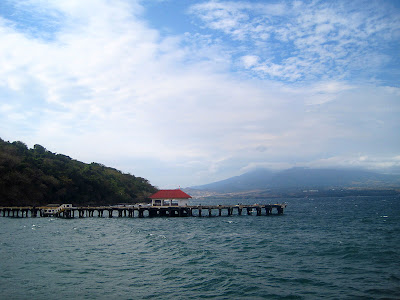*One thing you don’t know about the Dublin household is that its queen bee favored Philippine and World History more than any other subject in school. That and Literature.
So please forgive me if this turns into a history lesson of sorts. Corregidor is, after all, a chock-full of history encased in a tadpole-shaped island.
The sight of assorted clutter afloat the dock and tourist hordes all antsy to board their designated tramvias welcomed us as we alighted the Sun Cruises ferry after a dizzying hour-long cruise from the Manila Bay terminal.
Despite it being largely touristy, Corregidor – once Fort Mills – still dons that mysterious and enchanting physique even after refurbishments have been made since my last visit in 1993. It remains rather ghostly and haunting, perhaps partly due to the fact that except for the employees of Corregidor Inn Hotel, no other person is allowed to inhabit it.
Ironically though, it is the only island among a collection of other islets – including El Fraile (Fort Drum), La Monja (The Nun), Carabao (Fort Frank) and Caballo (Fort Hughes) Islands – that remains open for visits. All the others surrounding the coast are intended solely for the Philippine Navy’s perusal.
 |
| Sun Cruises terminal at the Manila Bay. Ferry leaves at 8-ish. |
 |
| Wicked sea/skyscape while leaving the Bay. |
“The island’s location is strategically important to the war because it blocks the entrance to Manila Bay,” the tour guide quips as we make our way to a series of batteries, all located on the island’s Topside – the biggest of three island portions (Top, Middle and Tail). This side of town once housed high-ranking officers, and is a crowd favorite for its magnificent fortifications, mean-looking ammos, and the Pacific War Memorial.
 |
| First stop: Middleside Barracks for a 5-minute photo op |
There are three main batteries, all named after American generals.
Battery Way is the smallest, with adjacent barracks that served as storage for ammunition.
Battery Hearn is the biggest thus most important battery. Its spring has been removed by an American architect during the invasion, rendering it useless.
 |
| Might not exactly be a mile long, but definitely the longest barracks in the country. Hurricane-proof, too. |
 |
Guests were given thirty minutes to roam around the Pacific War Memorial – four to six times the average stop time – vast and packed as it was. Us history zealots rejoiced. Much were to be seen on this area: Cine Corregidor, the war museum, statues and monkeys. Not kiddin’ on that last bit.
A variety of interesting WWII artifacts and paraphernalia are gathered at the museum, though it tends to be overlooked by non-history buffs who would rather muse at free-roaming monkeys and the ginormous Eternal Flame of Freedom memorial, which offers a rejuvenating view of the Bay and neighboring peninsulas.
 |
| The Eternal Flame of Freedom is dedicated to the struggles of everyone who fought for freedom during WWII. |
Authentic regalia included Japanese and American military uniforms, bloodstained flags, a handwritten note, coins and various weapons.
 |
| Cine Corregidor |
 |
| Cine Corregidor Ruins |
 |
| Abandon ship! Going back down from a treacherous mini-trek |
 |
| Souvenir shops with a communications tower at the back |
Lunch was served at the most popular hotel in the island, the Corregidor Inn Hotel. Note that I said most popular. Despite the insistence of tour guides that it is the only one in the island, there are actually a couple of cheaper lodges near the dock.
 |
| On the menu: greens, fresh fruits and ginataang halo-halo. Main entree included Seafood Paella, Carbonara, Pork BBQ, Ginisang Toge , Fried Chicken and soup. |
 |
| A statue of a Filipino Guerilla farmer. |
Back in the days, part of America’s war strategy was to have Filipinos guerillas and spies guised as farmers. The Japanese later distinguish who from who through the palm test: True farmers have hard, calloused palms. Guerillas didn’t.
 |
| Japanese fertility diety at the Japanese Garden of Peace |
Onward to the last leg of the tour, we passed by dugged out holes along the elevated road, which turned out to be American hiding caves.
 |
| American VS Japanese caves. American caves are elevated; those of the latter are created along the shore. |
A similar cave is visible along the rocky coastline, carved by the Japanese. Inside is a rail track with a suicide boat at the tunnel end, loaded with 250 kilograms of explosives. Should Japanese soldiers be forced to surrender, they are to steer this boat out in the open water and smash it on to the first vessel they see.
 |
| Japanese cave |
A commanding view of Boca Grande and Caballo Island jutting out of the water welcomed us as we headed down to the narrower Bottomside or Tailside, where the docks and most of the accommodations are situated (This is the only part of the island where further infrastructural projects are permitted). Farther away we saw a silhouette of El Fraile Island, a rock formation that was razed, scraped and fortified by the Americans to resemble an impregnable battleship and keep the Japanese at bay.
Geologists claim that El Fraile was once connected to Corregidor, and that what we see of the latter today are remnants of a once-active underground volcano. Reason why, as per Ms. Tour Guide, Corregidor tends to be warmer than average during summer months.
 |
| Did ya know? The famous “I shall return” line was actually proposed by Carlos P. Romulo, who served as McArthur’s press and media adviser. And McArthur said that line in Australia, not in Corregidor. |
The famous Lorcha Dock where Gen. Douglas McArthur set sail after the war. Fronting the dock is a small parcel of land, once called Barrio San Jose, which served as a community for the affluent in pre-war times.
 |
| Malinta Tunnel was named such because of the numerous leeches (linta) workers found inside during reconstruction. |
Corregidor may be too crowded. The water’s murky to swim in. And over 10,000 wandering Japanese souls could give you the spook should you decide to stay for the night at the haunted hotel. But this dreary island does leave a lasting imprint to those who are brave enough to accept inconvenient truths. It reminds one how expensive freedom is, to use it wisely by enriching his life with purpose.
 |
| Part of a painting hung at the Filipino-American Friendship Park. |
Aren’t you glad you now live in a highly civilized world, free and out of war?
























I've been to Corregidor a couple of times at different stages of my life. I'm looking forward to experiencing it with my daughter soon.
Super love Corregidor. We stayed there overnight and I've written posts about our trip. Super exhausting lang because of the heat but it's super worth it. =)
I haven't been to Corregidor. I hope soon. I hate history probably because my teacher wasn't good at presenting lessons kung nadiscover ko lang noon na mas matututo pala ako reading blogs e sana I would've appreciated our history back then. Hay.
Haha! You're not the girl to hate History. Actually, I know quite too many who do, and just a few who feel otherwise.
Swerte ng kids natin, nowadays madali na matuto. May Wikipedia na, may blogs pa.
Oooh…Did you do the ghost haunting tour?
I agree, it can get really hot, especially in the Japanese Garden, but it's all worth it 🙂
Your daughter would be lucky to visit Corregidor. Dami niya matutunan doon.
It's so nice. It's also great that they've preserved the ruins as these will remind generations to come what heroic battles their ancestors fought in order for them to have the freedom they are enjoying right now.
Kasama sa Life List ko yung mag-explore ng isang haunted place. I am considering Corregidor pero iniisip ko pa lang na pupunta ako at makakaramdam ng kung anek-anek, tumatayo agad ang balahibo ko. :)) Anyway, I would love to explore Corregidor this year.. during the day nga lang. 😀
I have been to Corregidor for a field trip when I was in college. They said that sharks swim near its waters. katakot! And although it was a nice historic place to visit, its still kinda eerie. Lalo na when we went inside the Malinta tunnel where it was dark. I kinda felt for all the soldiers that died during the WWII. My grandpa was a veteran and napaka sad nung mga stories na sinabi nya. He is actually a death march survivor.
Our tour guide did mention sharks as a joke, I thought hindi totoo! It's true, merely listening to stories makes you feel sad na. I salute your grandpa. Wow, a death march survivor. Must've been so traumatic for him.
Krisna, for me a daytrip is enough. If you want to do the ghost haunting, you could opt for the overnight. They do include that as part of the overnight package.
Agree. When you think of what our grandparents experienced during the war, it makes you really appreciate freedom as you have it.
I haven't been to Corregidor mainly because I didn't enjoy going to field trips back in school. But the place looks amazing and I'm now wishing we could go sometime. The food also looks divine! Hope to take my little family on a trip there!
I visited Corregidor like 10 years ago. It was fun but I want to visit this place again. Thanks for sharing.
Also, it's good to know that there are cheaper lodge available in the area. I thought that they have only one hotel there.
Ah, a revisit after a decade is very good indeed. The place is more hmm, streamlined now. They've made refurbishments, and the food that comes with the tour is much, much better.
The tour guides will tell you there is only one lodge, but people who have stayed overnight will tell you otherwise. If there's a cheaper alternative, I wouldn't mind checking it out either.
Thank you for the visit too!
Go mommy Roxi! If you're a history buff, it's gonna make a great daytrip.
Looks like a lovely place! I'm having a list of places in the Philippines to visit this year, will definitely have this one!!
That's great! I do hope you get to visit this one soon. It's a must for history buffs 🙂